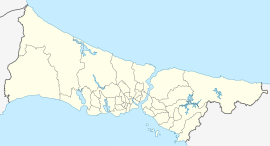This article includes a list of general references, but it lacks sufficient corresponding inline citations. (December 2017) |
Cihangir | |
|---|---|
 | |
| Coordinates: 41°01′59″N 28°59′07″E / 41.03306°N 28.98528°E | |
| Country | Turkey |
| Province | Istanbul |
| District | Beyoğlu |
| Government | |
| • Muhtar | Adnan Bal |
| Population (2022) | 3,739 |
| Time zone | UTC+3 (TRT) |
Cihangir is an affluent neighbourhood in the municipality and district of Beyoğlu, Istanbul Province, Turkey.[1] Its population is 3,739 (2022).[2] It is located between Taksim Square and Kabataş.[3] It has many narrow streets, two parks, and many street cafes especially in and around Akarsu Yokuşu Sokağı.
The neighbourhood has a bohemian reputation.[4] It is known for its artists, writers, actors, and expatriates – as well as its large army of street cats. It was also a stronghold for protesters during the Gezi Park protests.[3]
Cihangir was named after Şehzade Cihangir whose heartbroken father, Suleiman the Magnificent, had Mimar Sinan build a mosque overlooking the Bosphorus to commemorate his death. The name means "conqueror" in Turkish and, in turn, comes from the Persian compound word jahan + gir (جهانگیر), meaning "conqueror of the world". Today, the Cihangir Mosque, originally built in 1559 but reconstructed in 1889, offers views across the Bosphorus to Sarayburnu.[4]
In 2012, British newspaper The Guardian included Cihangir and neighbouring Çukurcuma in the list of the five best places in the world to live, next to Santa Cruz de Tenerife, in Spain; the district of Sankt Pauli, in Hamburg, the north coast of Maui, in Hawaii and Portland, in the U.S. state of Oregon.[5]
Ece Temelkuran wrote that this neighbourhood is like Soho, Manhattan.[6]
- ^ Mahalle, Turkey Civil Administration Departments Inventory. Retrieved 12 July 2023.
- ^ Cite error: The named reference
tuikwas invoked but never defined (see the help page). - ^ a b Delin, Sevil (2013-12-09). "A day in … Cihangir, Istanbul". The Guardian. ISSN 0261-3077. Retrieved 2019-05-23.
- ^ a b "Cornucopia Magazine". www.cornucopia.net. Retrieved 2019-05-23.
- ^ "Santa Cruz de Tenerife, uno de los cinco mejores sitios del mundo para vivir, según "The Guardian"". ABC.es. Retrieved 25 May 2015.
- ^ Temelkuran, Ece (2019). How to Lose a Country: The Seven Steps from Democracy to Dictatorship. London: HarperCollinsPublishers. p. 131. ISBN 978-0-00-829404-5.

